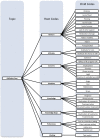Assessing and responding to palliative care needs in rural sub-Saharan Africa: results from a model intervention and situation analysis in Malawi
- PMID: 25313997
- PMCID: PMC4197005
- DOI: 10.1371/journal.pone.0110457
Assessing and responding to palliative care needs in rural sub-Saharan Africa: results from a model intervention and situation analysis in Malawi
Abstract
Introduction: Palliative care is rarely accessible in rural sub-Saharan Africa. Partners In Health and the Malawi government established the Neno Palliative Care Program (NPCP) to provide palliative care in rural Neno district. We conducted a situation analysis to evaluate early NPCP outcomes and better understand palliative care needs, knowledge, and preferences.
Methods: Employing rapid evaluation methodology, we collected data from 3 sources: 1) chart review of all adult patients from the NPCP's first 9 months; 2) structured interviews with patients and caregivers; 3) semi-structured interviews with key stakeholders.
Results: The NPCP enrolled 63 patients in its first 9 months. Frequent diagnoses were cancer (n = 50, 79%) and HIV/AIDS (n = 37 of 61, 61%). Nearly all (n = 31, 84%) patients with HIV/AIDS were on antiretroviral therapy. Providers registered 112 patient encounters, including 22 (20%) home visits. Most (n = 43, 68%) patients had documented pain at baseline, of whom 23 (53%) were treated with morphine. A majority (n = 35, 56%) had ≥1 follow-up encounter. Mean African Palliative Outcome Scale pain score decreased non-significantly between baseline and follow-up (3.0 vs. 2.7, p = 0.5) for patients with baseline pain and complete pain assessment documentation. Providers referred 48 (76%) patients for psychosocial services, including community health worker support, socioeconomic assistance, or both. We interviewed 36 patients referred to the NPCP after the chart review period. Most had cancer (n = 19, 53%) or HIV/AIDS (n = 10, 28%). Patients frequently reported needing income (n = 24, 67%) or food (n = 22, 61%). Stakeholders cited a need to make integrated palliative care widely available.
Conclusions: We identified a high prevalence of pain and psychosocial needs among patients with serious chronic illnesses in rural Malawi. Early NPCP results suggest that comprehensive palliative care can be provided in rural Africa by integrating disease-modifying treatment and palliative care, linking hospital, clinic, and home-based services, and providing psychosocial support that includes socioeconomic assistance.
Conflict of interest statement
Figures



Similar articles
-
The benefits, barriers, and specific needs of palliative care for adults with cancer in sub-Saharan Africa: a systematic review.Glob Health Action. 2025 Dec;18(1):2485742. doi: 10.1080/16549716.2025.2485742. Epub 2025 Apr 10. Glob Health Action. 2025. PMID: 40208058 Free PMC article.
-
Excellent clinical outcomes and retention in care for adults with HIV-associated Kaposi sarcoma treated with systemic chemotherapy and integrated antiretroviral therapy in rural Malawi.J Int AIDS Soc. 2015 May 29;18(1):19929. doi: 10.7448/IAS.18.1.19929. eCollection 2015. J Int AIDS Soc. 2015. PMID: 26028156 Free PMC article.
-
Palliative care needs and preferences of female patients and their caregivers in Ethiopia: A rapid program evaluation in Addis Ababa and Sidama zone.PLoS One. 2021 Apr 22;16(4):e0248738. doi: 10.1371/journal.pone.0248738. eCollection 2021. PLoS One. 2021. PMID: 33886561 Free PMC article.
-
Palliative care experiences of adult cancer patients from ethnocultural groups: a qualitative systematic review protocol.JBI Database System Rev Implement Rep. 2015 Jan;13(1):99-111. doi: 10.11124/jbisrir-2015-1809. JBI Database System Rev Implement Rep. 2015. PMID: 26447011
-
End-of-life care in rural areas: what is different?Curr Opin Support Palliat Care. 2012 Sep;6(3):391-7. doi: 10.1097/SPC.0b013e328356ab1f. Curr Opin Support Palliat Care. 2012. PMID: 22801467 Review.
Cited by
-
Socially, Culturally and Spiritually Sensitive Public Health Palliative Care Models in the Lower-income Countries: An Integrative Literature Review.Indian J Palliat Care. 2023 Jan-Mar;29(1):15-27. doi: 10.25259/IJPC_92_2022. Epub 2022 Sep 21. Indian J Palliat Care. 2023. PMID: 36846282 Free PMC article. Review.
-
Quality of life among cancer patients at Queen Elizabeth and Kamuzu Central Hospitals in Malawi: a cross-sectional double-center study.Afr Health Sci. 2022 Sep;22(3):222-232. doi: 10.4314/ahs.v22i3.24. Afr Health Sci. 2022. PMID: 36910374 Free PMC article.
-
Increasing utilisation of perinatal services: estimating the impact of community health worker program in Neno, Malawi.BMC Pregnancy Childbirth. 2020 Jan 6;20(1):22. doi: 10.1186/s12884-019-2714-8. BMC Pregnancy Childbirth. 2020. PMID: 31906939 Free PMC article.
-
Decentralized Heart Failure Management in Neno, Malawi.Glob Heart. 2023 Jun 16;18(1):35. doi: 10.5334/gh.1210. eCollection 2023. Glob Heart. 2023. PMID: 37334396 Free PMC article.
-
Delivering comprehensive HIV services across the HIV care continuum: a comparative analysis of survival and progress towards 90-90-90 in rural Malawi.BMJ Glob Health. 2018 Jan 12;3(1):e000552. doi: 10.1136/bmjgh-2017-000552. eCollection 2018. BMJ Glob Health. 2018. PMID: 29564158 Free PMC article.
References
-
- Harding R, Higginson IJ (2005) Palliative care in sub-Saharan Africa. Lancet 365(9475): 1971–1977. - PubMed
-
- Temel JS, Greer JA, Muzikansky A, Gallagher ER, Admane S, et al. (2010) Early palliative care for patients with metastatic non-small-cell lung cancer. NEJM 363(8): 733–742. - PubMed
-
- Eramova I, Matic S, Munz M (2007) HIV/AIDS treatment and care: clinical protocols for the WHO European Region. Available: http://www.euro.who.int/__data/assets/pdf_file/0004/78106/E90840.pdf. Accessed 2013 Dec 13.
-
- Simms V, Higginson IJ, Harding R (2012) Integration of palliative care throughout HIV disease. Lancet Infect Dis 12: 571–575. - PubMed
-
- Harding R, Simms V, Krakauer E, DeLima L, Downing J, et al. (2011) Quality HIV care to the end of life. Clinical Infectious Diseases 52(4): 553–554. - PubMed
Publication types
MeSH terms
Grants and funding
LinkOut - more resources
Full Text Sources
Other Literature Sources
Medical

